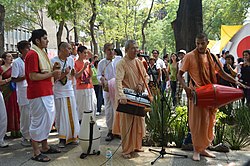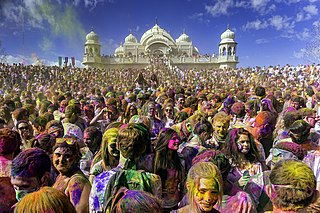 | |
| Total population | |
|---|---|
| Languages | |
| Sanskrit (Sacred) Spanish English Hindi |
Hinduism in Mexico is a minority religion. There were about 12,601 (0.01%) Hindus in Mexico as of 2020. [2] [3]
 | |
| Total population | |
|---|---|
| Languages | |
| Sanskrit (Sacred) Spanish English Hindi |
Hinduism in Mexico is a minority religion. There were about 12,601 (0.01%) Hindus in Mexico as of 2020. [2] [3]
| Year | Pop. | ±% |
|---|---|---|
| 2010 | 10,296 | — |
| 2020 | 12,601 | +22.4% |
| [4] [5] | ||
| Year | Percent | Increase in pop. % | Increase in% |
|---|---|---|---|
| 2010 | 0.009% | - | - |
| 2020 | 0.01% | +0.001% | 0.1% |
The Hindus in the country are mainly businessmen or professionals. Many of them work with one or the other international organisation or a multinational corporation. [6] There are also some academicians and scientists among them. They have helped to bring about a greater mutual understanding between India and their host country.
Most members of the diaspora speak Spanish and have adapted themselves admirably to their foreign environment.
A Sai Baba temple and a Vaishnav temple have been constructed in Mexico City by the Sangam Organisation. There are several center from some other worshippers as well.
The country got its first Ram Temple constructed in the city of Queretaro with the idols brought from India. [7]
ISKCON has 8 centres in Mexico. [8]
There are now 29 Sai centers in Mexico.
There are two Sai Schools in Mexico, one in Chihuahua and other in Cuernavaca. There are about 100 children in each school. [9]

Hinduism is a minority religion in South America, which is followed by even less than 1% of the total continent's population. Hinduism is found in several countries, but is strongest in the Indo-Caribbean populations of Guyana and Suriname. There are about 320,000 Hindus in South America, chiefly the descendants of Indian indentured laborers in the Guianas. There are about 185,000 Hindus in Guyana, 120,000 in Suriname, and some others in French Guiana. In Guyana and Suriname, Hindus form the second largest religion and in some regions and districts, Hindus form the majority. Though in recent times, due to influence of Hindu culture the number of Hindus converts have increased in other countries in South America, including Brazil, Argentina, Venezuela and others.

Hinduism has been spread in Russia primarily due to the work of scholars from the religious organization International Society for Krishna Consciousness (ISKCON) and by itinerant Swamis from India and small communities of Indian immigrants. While ISKCON appear to have a relatively strong following in Russia, the other organizations in the list have a marginal presence in this country. There is an active Tantra Sangha operating in Russia. According to the 2012 official census, there are 140,010 Hindus in Russia, which accounts for 0.1% population of Russia.

Hinduism is the third largest religion in Australia consisting of more than 684,002 followers, making up 2.7% of the population as of the 2021 census. Hinduism is the fastest growing religion in Australia mostly through immigration. Hinduism is also one of the most youthful religions in Australia, with 34% and 66% of Hindus being under the age of 14 and 34 respectively.

Hinduism is the Fourth-largest religion in Myanmar, being practised by 1.7% of the population of Myanmar. Hinduism is practised by about 890,000 people in Myanmar, and has been influenced by elements of Buddhism, with many Hindu temples in Myanmar housing statues of the Buddha. There are also a large population of Hindus in which the Myanmar Tamils and minority Bengali Hindus having the biggest population share.

Hinduism is a minor religious faith in Finland.

Hinduism is a minority religion constituting about 0.15% of the population of Austria. Hinduism is not one of the 16 recognised religions in Austria. The Austrian law allows religious groups not recognized as societies to seek official status as confessional communities with the Office for Religious Affairs. Hinduism is one of the eight confessional communities in Austria. However, the Sahaja Yoga and the International Society for Krishna Consciousness are categorised as associations, not as confessional communities.
Hinduism is currently practiced by a minority of residents of China. The religion itself has a very limited presence in modern mainland China, but archaeological evidence suggests a significant presence of Hinduism in different provinces of medieval China. Hindu influences were also absorbed in to Buddhism and got mixed with Chinese mythology over its history. Practices originating in the Vedic tradition of ancient India such as yoga and meditation are also popular in China.

Hinduism is the third largest religious group in the United Kingdom, after Christianity and Islam; the religion is followed by around 1.7% of the total population of the nation. Hindus had a presence in the United Kingdom since the early 19th century, as at the time India was part of the British Empire. Many Indians in the British Indian Army settled in the United Kingdom of Great Britain and Northern Ireland. According to 2021 United Kingdom census, 1,032,775 residents (1.7%) identified themselves as Hindus.

Hinduism is a minority religion practised by 0.3% of the population of Botswana. The practice of Hinduism in Botswana is concentrated in and around Gaborone and Selebi-Phikwe. The community of Hindus began to form in the early 20th century with the beginning of immigration from India to Botswana. Most Hindus in Botswana are of Indian descent.

Hinduism in Mongolia is a minority religion; it has few followers and only began to appear in Mongolia in the late twentieth century. According to the 2010 and 2011 Mongolian census, the majority of people that identify as religious follow Buddhism (86%), Shamanism (4.7), Islam (4.9%) or Christianity (3.5). Only 0.5% of the population follow other religions.

Hinduism in Azerbaijan has been tied to cultural diffusion on the Silk Road. One of the remnants of once-dominant Hindu and Buddhist culture in the Caucasus is Surakhani, the site of the Ateshgah of Baku. As of 2020, there were about 500 Hindus in Azerbaijan.
Hinduism in Kazakhstan is represented mainly by the ISKCON followers and by expatriate Hindus from India. The Census in Kazhakhstan doesn't recognize Hinduism. According to an estimate, there are about 500 Hare Krishna devotees in Kazakhstan. In 2010, there were 801 (0.005%) Hindus in Kazakhstan according to the ARDA. As of 2020, there were about 1878 (0.01%) Hindus in Kazakhstan.

Hinduism is a minority religion in Belgium. According to the PEW 2014, Hinduism is also the fastest growing religion in Belgium. Attempts have been done by the Hindu Forum of Belgium (HFB) to make Hinduism an officially-recognized religion in Belgium.

Hinduism was first introduced by Sindhi settlers who migrated to Ghana after India was divided in 1947. It was spread to Ghana actively by Ghana's Hindu Monastery headed by Swami Ghananand Saraswati and by the International Society for Krishna Consciousness (ISKCON). Hinduism is one of the fastest growing religions in Ghana.

Hinduism in Poland is a minority religion. Hinduism has spread to Poland through ISKCON since 1976. First groups of Polish devotees were established in Warsaw and Wrocław. The first Polish Hindu temple was established in 1980 in Czarnów, Lower Silesian Voivodeship. Main ISKCON temple is New Ramana Reti Temple in Mysiadło.

Hinduism is a minority religion and a fairly recent development in Lithuania. Hinduism is spread in Lithuania by Hindu organizations: ISKCON, Sathya Sai Baba, Brahma Kumaris and Osho Rajneesh. As of 2015, there were 580 (0.02%) Hindus in Lithuania.

Hinduism is a minority faith in Denmark. There are 40,000 (0.5%) Hindus in Denmark as of 2020.
Hinduism in North Macedonia is mainly represented by the Hare Krishna movement (ISKCON) and the Sathya Sai Baba Organisation. ISKCON and the Satya Sai Baba-Centre have been registered in Macedonia as a part of the Oriental religion.

The reception of Hinduism in the Western world began in the 19th century, at first at an academic level of religious studies and antiquarian interest in Sanskrit.

Rama Navami is a Hindu festival that celebrates the birth of Rama, one of the most popularly revered deities in Hinduism, also known as the seventh avatar of Vishnu. He is often held as an emblem within Hinduism for being an ideal king and human through his righteousness, good conduct and virtue. The festival falls on the ninth day of the bright half of the lunar cycle of Chaitra (March–April), the first month in the Hindu calendar. It is also part of the Chaitra Navaratri festival in spring. Rama Navami is a holiday for government employees in India.